
From Excavators to Earthquakes: Achieving Redundant Networks
- Cloud networking
- May 24, 2021
- RSS Feed
By Darren Wilson, Chief Operating Officer
We look at the challenges connectivity providers face with achieving fully redundant networks, and share our tips on how to check your provider's redundancy.
In March, the world turned its attention to France as a fire destroyed several data centers, disrupting millions of websites and businesses in the process. It’s easy to forget that the internet, and the cloud, rely on physical infrastructure, but this event was an abrupt reminder.
When digital infrastructure goes down, it can spell disaster for companies around the world. Whether it’s data centers, subsea cables, or fiber, the infrastructure connecting our networks spans every landscape, ranging from arid deserts to ocean floors, and cable-related redundancy incidents happen constantly.
In this article we’ll dive into these incidents, ranging from the regular to the rare, and give you some questions to ask your Network as a Service (NaaS) provider to find out how they architect their network to minimize the customer impact of these incidents.
A closer look at Megaport’s network redundancy
We manage over 2,000 circuits globally and detect, on average, approximately seven reduced redundancy infrastructure events each month. The vast majority of these outages are restored within 24 hours.
The most common cause of latency changes is when traffic reroutes to a geographically diverse path. But when networks are designed and implemented correctly, customer traffic will reroute seamlessly around unplanned infrastructure downtime, so any latency changes almost go unnoticed.
Following larger incidents, restoration activities can take days. In these situations, our operations teams will regularly verify the network status and provide real-time updates to our customers until the issue is resolved. Plus, we’re always available if customers want to check in or get specialized support.
What types of incidents can impact network redundancy?
Once connection cables are laid into the ground underneath roads or across the bottom of the ocean they need to be maintained, and every 15 to 30 years, they need to be replaced. The vast majority of redundancy incidents are due to human error during this maintenance. With urban sprawl, growing cities, expanding road networks, and other construction, cables are accidentally cut all the time. Because cable repair is usually straightforward, these issues are often solved within hours.
“Stranger things do happen…In the Australian outback, wombats have been known to burrow into the ground and disturb cable ducts.”
Some incidents take longer to fix, and can impact much larger areas. Earthquakes, for example, commonly shear cables in the ocean as tectonic plates shift. And because cables on land often follow roads, events like landslides can take out kilometers of cable. These outages can take weeks to repair.
Now and then, stranger things do happen. In the Australian outback, animals like wombats have been known to burrow into the ground and disturb cable ducts. And yes, those stories of curious sharks biting undersea cables are true—but they rarely cause outages, especially with the way today’s cables are designed.
According to Telegeography’s Submarine Cable Map, as of 2021 there are approximately 426 cables globally, spanning a total of more than 1.3 million kilometers.
Check your NaaS provider’s network redundancy
Because of the global infrastructure we rely on for our connectivity, there’s really no possibility of zero redundancy incidents. But for some industries, downtime is critical. Broadcast media is a great example; if your connection goes down during a sports game or live interview, your revenue comes to a halt because your sponsors and advertisers lose connection, too. If you’re in one of these industries (or even if you’re not), here are some network redundancy questions you can ask your NaaS provider.
Read our blog post on improving network redundancy with ExpressRoute Global Reach here.
What’s your backup plan?
A well-adopted industry practice, not just in tech but in most industries, is to always have a backup. This is the most obvious question you can ask your provider—do they have more than one way to get you online or to the cloud if one of their paths goes down? The more backups they have, the safer you are. The way Megaport secures such high availability is to have many well-connected PoPs worldwide, and backup routes for most situations that could affect our customers’ connectivity. But availability alone isn’t enough.
How much does this high availability cost?
If your availability requirements aren’t being met by your NaaS or telecommunications provider, it can often be hard to get out of the lengthy and expensive contracts you’re locked into, so checking how much this availability costs ensures you’re not overpaying for a redundant network.
Megaport’s edge over other industry players is that we have availability as well as scalability, with our pay-as-you-go billing model. With Megaport, you can turn up speedy connections in seconds with our “point, click, connect” setup, and you pay only for the bandwidth you consume; you can turn it off whenever you like with no penalties.
But even with a lot of PoPs, high availability, and the added benefit of scalability, unexpected outages can still happen, so it’s worth checking one last thing with your NaaS provider.
How do you communicate redundancy issues with your customers?
An effective provider will show transparency: communicating what they know as they learn it, to guide customers through even the most unpredictable situations. This allows you to effectively plan around the outage and feel assured that your provider is working with you to do this. That’s an ethos Megaport is always aiming for: transparency and visibility.
In a world reliant on being constantly connected, minimizing redundancy incidents is fundamentally important to enterprise success. Understanding the types of incidents impacting network redundancy—and knowing what questions to ask your NaaS provider—is a great way to ensure your company stays connected.
Want to take a deeper dive into the technical side of achieving network redundancy? Read our earlier blog post here.



